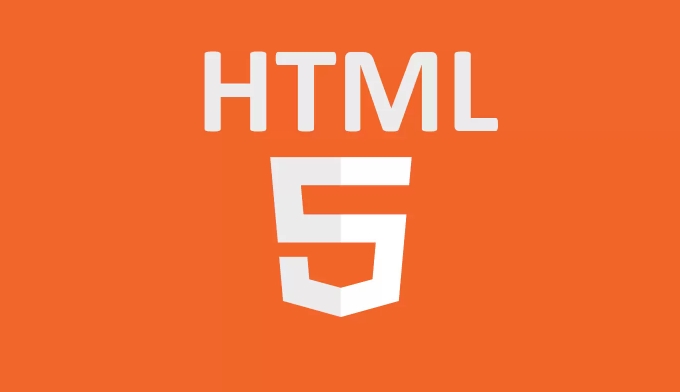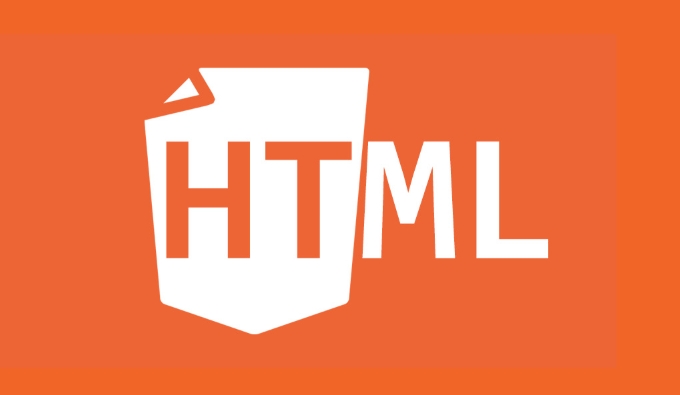The difference between HTML elements and HTML tags is: 1. HTML tags are syntax structures in the code, used to define elements, such as
and
; 2. HTML elements are objects generated by the browser after parsing tags, including tags, contents and attributes. Tags are text characters used when writing HTML, while elements are actual objects formed when the browser builds a document structure (DOM) and interact with elements during JavaScript operations or CSS-style applications. Understanding this difference helps avoid confusion in debugging and technical discussions.
When people ask about the difference between an HTML element and an HTML tag, it often comes down to terminology. While they're related, they don't mean exactly the same thing. Understanding this distinction helps when reading documentation or working through more technical explanations.

HTML Tags Are the Building Blocks
HTML tags are what you type in your code to define elements. They start with a less-than sign , end with a greater-than sign <code>> , and usually contains a keyword like p , div , or a . For example:

- Opening tag:
<p></p> - Close tag:
Tags tell the browser where an element starts and (usually) ends. Some tags are self-closing, like <img src="/static/imghw/default1.png" data-src="https://img.php.cn/upload/article/000/000/000/175225483792511.jpeg" class="lazy" alt="What is the difference between an HTML element and an HTML tag?" > or <br> , which means they don't need a separate closing tag.
You can think of tags as the syntax that tells the browser how to create elements in the page structure.

Elements Are What the Browser Understands
Once the browser reads your HTML tags, it creates something called an element. An element is the actual object in the document tree (also known as the DOM — Document Object Model). It includes everything defined by the tag or pair of tags, plus any content inside them and the attributes applied.
For example:
<p class="intro">Hello, world!</p>
In this case:
-
<p class="intro"></p>andare the tags - The entire paragraph, including the text "Hello, world!" and the
class="intro"attribute, forms the element
So, elements are the result of processing the tags. You interact with elements when using JavaScript or applying CSS styles.
Why the Difference Matters
Knowing whether someone is referring to a tag or an element can help avoid confusion, especially when debugging or reading technical discussions. Here are a few situations where the distinction matters:
-
When talking about syntax vs. structure
- "I forget to close the tag" refers to writing the HTML.
- “The element isn't showing up” refers to how the browser rendered it.
-
In JavaScript and the DOM
- Methods like
document.createElement('div')create an element, not a tag. - When you log an element to the console, you're seeing the processed version, not the raw tag.
- Methods like
-
In SEO or accessibility discussions
- People might say “use the header tag,” but what they really care about is the semantic meaning of the heading element in the page structure.
Summary
To recap:
- Tags are the literal characters in your HTML file, like
<p></p>and. - Elements are the objects the browser builds from those tags, including their content and attributes.
It's a subtle difference, but one that becomes useful when diving deeper into web development. If you're just starting out, you'll likely hear the terms used interchangeably — and that's OK. But knowing the nuance gives you a clearer foundation for future learning.
Basically that's it.
The above is the detailed content of What is the difference between an HTML element and an HTML tag?. For more information, please follow other related articles on the PHP Chinese website!

Hot AI Tools

Undress AI Tool
Undress images for free

Undresser.AI Undress
AI-powered app for creating realistic nude photos

AI Clothes Remover
Online AI tool for removing clothes from photos.

Clothoff.io
AI clothes remover

Video Face Swap
Swap faces in any video effortlessly with our completely free AI face swap tool!

Hot Article

Hot Tools

Notepad++7.3.1
Easy-to-use and free code editor

SublimeText3 Chinese version
Chinese version, very easy to use

Zend Studio 13.0.1
Powerful PHP integrated development environment

Dreamweaver CS6
Visual web development tools

SublimeText3 Mac version
God-level code editing software (SublimeText3)

Hot Topics
 Explain the purpose of the role attribute in ARIA.
Jun 14, 2025 am 12:35 AM
Explain the purpose of the role attribute in ARIA.
Jun 14, 2025 am 12:35 AM
ARIA's role attribute is used to define the role of web elements and improve accessibility. 1. Role attribute helps assistive technology to understand the functions of elements, such as buttons, navigation, etc. 2. Use role attributes to assign specific roles to non-semantic HTML elements. 3. The role attribute should be consistent with the element behavior and be verified by the accessibility tool test.
 HTML and Design: Creating the Visual Layout of Websites
Jun 14, 2025 am 12:39 AM
HTML and Design: Creating the Visual Layout of Websites
Jun 14, 2025 am 12:39 AM
How to create a website layout? 1. Use HTML tags to define the content structure, such as, ,. 2. Control styles and positions through CSS, using box model, float or Flexbox layout. 3. Optimize performance, reduce HTTP requests, use cache and optimize images, and ensure responsive design.
 How do I stay up-to-date with the latest HTML standards and best practices?
Jun 20, 2025 am 08:33 AM
How do I stay up-to-date with the latest HTML standards and best practices?
Jun 20, 2025 am 08:33 AM
The key to keep up with HTML standards and best practices is to do it intentionally rather than follow it blindly. First, follow the summary or update logs of official sources such as WHATWG and W3C, understand new tags (such as) and attributes, and use them as references to solve difficult problems; second, subscribe to trusted web development newsletters and blogs, spend 10-15 minutes a week to browse updates, focus on actual use cases rather than just collecting articles; second, use developer tools and linters such as HTMLHint to optimize the code structure through instant feedback; finally, interact with the developer community, share experiences and learn other people's practical skills, so as to continuously improve HTML skills.
 How do I use the element to represent the main content of a document?
Jun 19, 2025 pm 11:09 PM
How do I use the element to represent the main content of a document?
Jun 19, 2025 pm 11:09 PM
The reason for using tags is to improve the semantic structure and accessibility of web pages, make it easier for screen readers and search engines to understand page content, and allow users to quickly jump to core content. Here are the key points: 1. Each page should contain only one element; 2. It should not include content that is repeated across pages (such as sidebars or footers); 3. It can be used in conjunction with ARIA properties to enhance accessibility. Usually located after and before, it is used to wrap unique page content, such as articles, forms or product details, and should be avoided in, or in; to improve accessibility, aria-labeledby or aria-label can be used to clearly identify parts.
 How do I create a basic HTML document?
Jun 19, 2025 pm 11:01 PM
How do I create a basic HTML document?
Jun 19, 2025 pm 11:01 PM
To create a basic HTML document, you first need to understand its basic structure and write code in a standard format. 1. Use the declaration document type at the beginning; 2. Use the tag to wrap the entire content; 3. Include and two main parts in it, which are used to store metadata such as titles, style sheet links, etc., and include user-visible content such as titles, paragraphs, pictures and links; 4. Save the file in .html format and open the viewing effect in the browser; 5. Then you can gradually add more elements to enrich the page content. Follow these steps to quickly build a basic web page.
 What is an HTML tag?
Jun 13, 2025 am 12:36 AM
What is an HTML tag?
Jun 13, 2025 am 12:36 AM
HTMLtagsareessentialforstructuringwebpages.Theydefinecontentandlayoutusinganglebrackets,ofteninpairslikeand,withsomebeingself-closinglike.HTMLtagsarecrucialforcreatingstructured,accessible,andSEO-friendlywebpages.
 How do I create checkboxes in HTML using the element?
Jun 19, 2025 pm 11:41 PM
How do I create checkboxes in HTML using the element?
Jun 19, 2025 pm 11:41 PM
To create an HTML checkbox, use the type attribute to set the element of the checkbox. 1. The basic structure includes id, name and label tags to ensure that clicking text can switch options; 2. Multiple related check boxes should use the same name but different values, and wrap them with fieldset to improve accessibility; 3. Hide native controls when customizing styles and use CSS to design alternative elements while maintaining the complete functions; 4. Ensure availability, pair labels, support keyboard navigation, and avoid relying on only visual prompts. The above steps can help developers correctly implement checkbox components that have both functional and aesthetics.
 How do I minimize the size of HTML files?
Jun 24, 2025 am 12:53 AM
How do I minimize the size of HTML files?
Jun 24, 2025 am 12:53 AM
To reduce the size of HTML files, you need to clean up redundant code, compress content, and optimize structure. 1. Delete unused tags, comments and extra blanks to reduce volume; 2. Move inline CSS and JavaScript to external files and merge multiple scripts or style blocks; 3. Simplify label syntax without affecting parsing, such as omitting optional closed tags or using short attributes; 4. After cleaning, enable server-side compression technologies such as Gzip or Brotli to further reduce the transmission volume. These steps can significantly improve page loading performance without sacrificing functionality.






